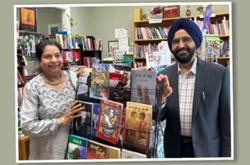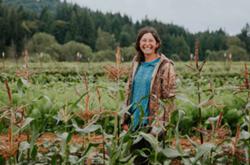
It's strawberry season. James and I are at the Ellis Farms u-pick on Delta's Westham Island, crouching between long rows of the bunchy green plants, plucking the big berries and dropping them gently into small buckets. We imagine their future with cream and in pies. I lick the sweet red juice from my fingers. "If I make jam we can have strawberries all year," I say. James asks with what, exactly, I plan to make the jam? Sugar? One of the planet's most exploitative products, shipped in from thousands of kilometres away?
"But what," I reply, "will we eat all winter?"
This may seem like a peculiar question in an age when it's normal to have Caribbean mangoes in winter and Australian pears in spring. However, on March 21, the first day of spring, we took a vow to live with the rhythms of the land as our ancestors did. For one year we would only buy food and drink for home consumption that was produced within 100 miles of our home, a circle that takes in all the fertile Fraser Valley, the southern Gulf Islands and some of Vancouver Island, and the ocean between these zones. This terrain well served the European settlers of a hundred years ago, and the First Nations population for thousands of years before.
This may sound like a lunatic Luddite scheme, but we had our reasons. The short form would be: fossil fuels bad. For the average American meal (and we assume the average Canadian meal is similar), World Watch reports that the ingredients typically travel between 2,500 and 4,000 kilometres, a 25 percent increase from 1980 alone. This average meal uses up to 17 times more petroleum products, and increases carbon dioxide emissions by the same amount, compared to an entirely local meal.
Let's translate that into the ecological footprint model devised by Dr. William Rees of UBC which measures how many planets'-worth of resources would be needed if everyone did the same. If you had an average North American lifestyle in every other way, from driving habits to the size of your house, by switching to a local diet you would save almost an entire planet's worth of resources (though you'd still be gobbling up seven earths).
Mmmm, good?
But forget about virtue. Think instead about the pure enjoyment that should come with eating. Few would deny that all this seasonless supermarket produce often has very little taste. Those grapefruits the size of your head, and strawberries the size plums used to be, have the consistency of cardboard. On the other hand, we took our inspiration from a meal we created entirely from the bounty around us while staying at our off-the-grid cabin in northern British Columbia: a Dolly Varden trout, chanterelle mushrooms, dandelion greens and potatoes--all from the fields, forests, and streams within easy walking distance.
So our rules, when we began, were purist. It was not enough for food to be locally produced (as in bread made by local bakers.) No. Every single ingredient had to come from the earth in our magic 100-mile circle. Our only "out" was that we were allowed to eat occasionally in restaurants or at friends' houses as we always had, so that we did not have to be social outcasts for a year. And, if we happened to travel elsewhere, we could bring home foods grown within a hundred miles of that new place.
Immediately there were problems. First was the expense. We used to eat a nearly vegan diet at home-our dwindling bank accounts emphasized how much cheaper beans, rice and tofu are than wild salmon, oysters and organic boutique cheeses.
Shrinking butts
Then, we wasted away. We were unable to find any locally grown grains-no more bread, pasta, or rice. The only starch left to us was the potato. Between us, we lost about 15 pounds in six weeks. While I appreciated the beauty and creativity of James' turnip sandwich, with big slabs of roasted turnip as the "bread," this innovation did little to stave off the constant hunger. James' jeans hung down his butt like a skater boy. He told me I had no butt left at all.
At the end of these desperate six weeks, we loosened our rules to include locally milled flour. Anita's, the one local company we found, said they got their organic grains from the Peace district and from Saskatchewan. We decided this would have to do. We had phoned a couple of local organic farmers who, on the Certified Organic Associations of BC website, listed wheat among their products, but one said he no longer did it, and the other never returned our call. Surely, 100 years ago, farmers grew wheat in the Fraser Valley to supply local needs, but the global market system is a disincentive to such small-scale production. There's no competing with the huge agri-businesses that have cloaked the Canadian prairies with grain.
Then there was a lack of variety. From March 21 until the farmers' markets started in mid-May, the only locally grown vegetables available were humble fare like kale, cabbage, turnip, rutabaga, parsnip and leeks. By late April, even these ran out in our West Side neighbourhood stores-Capers, IGA, Safeway, New Apple, and the Granville Island market-and only U.S.-grown versions were available. For a couple of weeks we wondered if it would be possible to go on with this crazy diet. We could walk into, say, an IGA and look down all those glittering aisles, and there was not a single thing we could buy.
On a late-April visit to Victoria I checked out a Thrifty's supermarket, and they had a local organic salad mix. I bought a huge bag to bring home-at $17.99 a pound. While we are grateful to have a Capers near our home, we were frustrated that, for about two weeks after local lettuces were for sale at the Trout Lake farmer's market, Capers continued to sell only organic greens from California.
Farmers' market heaven
Now that the farmers' markets are in full swing, we are perfectly content with the 100-Mile Diet. But the markets end in September. What to do from then until next March? My thoughts turn to preserves. Then it comes back to the sugar question.
"Couldn't we use honey?" James says as we survey our 26 pounds of fresh-picked strawberries.
"I don't think it will 'jam' with just honey," I say. "And you need so much sugar-I can't imagine what that much honey would cost."
The strawberry lady tells us that the Cameron family sells honey just up the road, so we drive there to find out the cost. The bee lady, Gail Cameron, walks out of her bungalow when she hears the crunch of our tires on the driveway. She tells us that this is the first honey of the season, blueberry, and she gives us a sample on a popsicle stick. It is the sweetest, most delicious honey I've ever had. We buy a kilogram for $11. (A kilogram of sugar costs $2.59.)
At home I heat a few saucepots of strawberries until they release their own juices, and grudgingly add one cup of precious honey, to make a grand total of two large jars of preserves. I was right, they don't "jam," but we do end up with a tasty sauce. We pray for good bulk rates when summer sunshine gets the bees making more honey, but we suspect that honey is out of our reach as a means of preserving a winter's worth of fruit. But there is détente for now on the sugar question-at least until blueberry season next month.
Alisa Smith and J.B. MacKinnon will be writing twice a month on The Tyee about their attempt to eat well on the 100-Mile Diet. For more information on finding locally produced food visit the web site of FarmFolk/CityFolk at www.farmfolkcityfolk.ca ![]()
Read more: Local Economy

















Tyee Commenting Guidelines
Comments that violate guidelines risk being deleted, and violations may result in a temporary or permanent user ban. Maintain the spirit of good conversation to stay in the discussion.
*Please note The Tyee is not a forum for spreading misinformation about COVID-19, denying its existence or minimizing its risk to public health.
Do:
Do not: